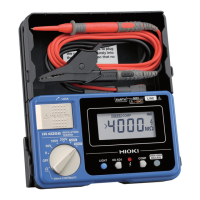What to do if the settings data has been corrupted on Hioki IR4056 Test Equipment?
- CCandace ScottSep 12, 2025
Repair is required.

What to do if the settings data has been corrupted on Hioki IR4056 Test Equipment?
Repair is required.
What to do if the measured value is the maximum on Hioki IR4056?
If the measured value is shown as the maximum display value when using Hioki Test Equipment, check the continuity of the test lead with a tester. Also, verify that the test leads are securely connected to both the instrument and the measurement points.
How to troubleshoot Hioki IR4056 when unable to perform measurement?
If you are unable to perform a measurement with your Hioki Test Equipment, try turning off the MEASURE key and then pressing it again. Also, make sure to separate the measurement target from all power sources before taking measurements.
Why do the batteries run out so fast in my Hioki IR4056?
If the batteries in your Hioki Test Equipment run out immediately, replace the nickel-metal-hydride or manganese batteries with alkaline batteries.
What causes excessive variation in measured values on Hioki Test Equipment?
If you experience excessive variation in the measured value with your Hioki Test Equipment, it could be due to induced noise from a nearby charging circuit. Try disconnecting the circuit breaker for any nearby charging circuits. If this isn't possible, use the lowest measured value as your result. Another cause could be a large capacitance component in the measurement target. If possible, remove the capacitor; otherwise, use the lowest measured value.
How to measure in 500 V or 1,000 V range on Hioki IR4056?
If you are unable to perform a measurement in the 500 V or 1,000 V range on your Hioki Test Equipment, press after setting the rotary selector to the 500 V or 1,000 V range. Note that pressing while holding the MEASURE key will not disable the lock function.
What to do if the voltage generation circuit is broken on Hioki IR4056 Test Equipment?
Repair is required.
What to do if the pre-adjustment data has been corrupted on Hioki IR4056?
Repair is required.
How to fix a broken protective fuse in Hioki IR4056 Test Equipment?
If there is a broken connection in the protective fuse of your Hioki Test Equipment, replace the indicated fuse.
Why is the insulation resistance accuracy outside specifications on Hioki IR4056?
If, when calibrating your Hioki Test Equipment, the accuracy of the insulation resistance range falls outside the device specifications, use the test leads that came with the instrument or its optional test leads to perform the calibration procedure. The issue might be that the test lead cable insulation resistance is too low.
| Insulation Resistance Test Voltage | 50 V, 250 V, 500 V, 1000 V |
|---|---|
| AC Voltage Measurement | 0 to 600 V |
| Display | Digital, Analog Bar Graph |
| Power Supply | LR6 alkaline battery |
| Dimensions | 159 mm W × 177 mm H × 53 mm D |
| Weight | Approx. 600 g |
| Safety Standards | EN61010-1 |
Confirm the instrument's condition and verify all included accessories upon receipt.
Lists optional accessories for the IR4000 series instruments.
Explains symbols used in the manual and on the instrument for safe operation.
Details symbols for danger, warning, caution, notes, and standard compliance marks like CE and WEEE.
Describes the insulation tester and highlights its key features.
Identifies and explains the functions of the instrument's front panel controls and display.
Details steps for preparing the instrument for measurement, including attaching strap and inserting batteries.
Guides on checking battery life and test lead condition before performing measurements.
Explains how to set up and use the comparator function for PASS/FAIL judgments.
Explains the procedure for measuring insulation resistance and selecting test voltage.
Instructions for measuring AC and DC voltages, including safety precautions.
Guide to performing low resistance measurements and the necessary zero adjustment.
Lists the standard functions and indicators of the insulation tester.
Details operating conditions, power source, dimensions, and other general specifications.
Details accuracy guarantees and specific measurement ranges for insulation resistance.
Provides detailed specifications for insulation resistance measurement, including functions and indicators.
Provides guidance on identifying and resolving common operational problems and error displays.
Instructions and precautions for replacing the instrument's batteries and fuse.
Guidelines for safely cleaning the instrument's exterior and display.
Explains the basic principles behind insulation resistance and low resistance measurements.
Details the operational uncertainty and influence quantities approved by EN/IEC61557.